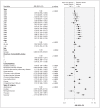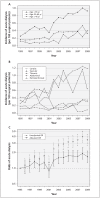Secular trends in acute dialysis after elective major surgery--1995 to 2009
- PMID: 22733671
- PMCID: PMC3414596
- DOI: 10.1503/cmaj.110895
Secular trends in acute dialysis after elective major surgery--1995 to 2009
Abstract
Background: Acute kidney injury is a serious complication of elective major surgery. Acute dialysis is used to support life in the most severe cases. We examined whether rates and outcomes of acute dialysis after elective major surgery have changed over time.
Methods: We used data from Ontario's universal health care databases to study all consecutive patients who had elective major surgery at 118 hospitals between 1995 and 2009. Our primary outcomes were acute dialysis within 14 days of surgery, death within 90 days of surgery and chronic dialysis for patients who did not recover kidney function.
Results: A total of 552,672 patients underwent elective major surgery during the study period, 2231 of whom received acute dialysis. The incidence of acute dialysis increased steadily from 0.2% in 1995 (95% confidence interval [CI] 0.15-0.2) to 0.6% in 2009 (95% CI 0.6-0.7). This increase was primarily in cardiac and vascular surgeries. Among patients who received acute dialysis, 937 died within 90 days of surgery (42.0%, 95% CI 40.0-44.1), with no change in 90-day survival over time. Among the 1294 patients who received acute dialysis and survived beyond 90 days, 352 required chronic dialysis (27.2%, 95% CI 24.8-29.7), with no change over time.
Interpretation: The use of acute dialysis after cardiac and vascular surgery has increased substantially since 1995. Studies focusing on interventions to better prevent and treat perioperative acute kidney injury are needed.
Figures







References
-
- Weiser TG, Regenbogen SE, Thompson KD, et al. An estimation of the global volume of surgery: a modelling strategy based on available data. Lancet 2008;372:139–44 - PubMed
-
- Chertow GM, Burdick E, Honour M, et al. Acute kidney injury, mortality, length of stay, and costs in hospitalized patients. J Am Soc Nephrol 2005;16:3365–70 - PubMed
-
- Waikar SS, Curhan GC, Wald R, et al. Declining mortality in patients with acute renal failure, 1988 to 2002. J Am Soc Nephrol 2006;17:1143–50 - PubMed
-
- Xue JL, Daniels F, Star RA, et al. Incidence and mortality of acute renal failure in Medicare beneficiaries, 1992 to 2001. J Am Soc Nephrol 2006;17:1135–42 - PubMed
-
- Hsu CY. Where is the epidemic in kidney disease? J Am Soc Nephrol 2010;21:1607–11 - PubMed
Publication types
MeSH terms
Grants and funding
LinkOut - more resources
Full Text Sources
Medical
